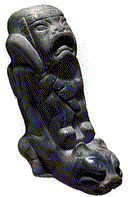
I would like to introduce you to a beautiful Olmec sculpture named 'Supernatural Riding a Jaguar'. I came across this interesting sculpture while researching the Olmec civilization through www.tribalarts.com/feature/olmec. I chose this sculpture because of its detail and how many things are represented in the one piece. This is a great example of the art that the Olmec people created as explained in my components A and B of Project 2.
The Olmec people were very detailed and descriptive in their sculptures. They made their sculptures out of rock basalt, jade, greenstone, terracotta, and in this case, jadite. Since the materials used were so hard, I can only assume that it took a tremendous amount of practice to gain the expertise needed to be able to create such a detailed sculpture (as represented in my first person account of an Olmec sculptor in component B). What type of tools do you imagine they used to create such works of art? The tools must have been carved from stone themselves in order to be able to carefully chip away at the sculpture materials. Were the tools different shapes to create carvings with different intricacies? Perhaps, but the limited objects left behind from the Olmec civilizations do not tell all that we may want to know.
As you will notice, there are no sharp edges on this or on any Olmec sculptures that I have seen. Was there a reason behind this? Did the roundness or smooth curves possibly represent something? How, with extremely primitive tools, were the sculptures made so smooth? Today, we would use grinders, sandpaper, polishes, etc. to achieve such a texture. Did they have such things thousands of years ago? Could the clay, or sandy soil that they lived on, have been used to create such polished?
I would like to point out some interesting details about this sculpture. This sculpture shows an Olmec man, or shaman, standing on a jaguar. The large head leads me to assume that this is a ruler, as large heads were a sign of a high socioeconomic position. The figure is holding a weapon or club or some sort, which I believe would represent him as a great hunter or warrior. The body is in a standing position and the feet are visible, which represents the environment (body), and the roots (feet) penetrating into the underworld (stability). The jaguar represents a spiritual companion and is pictures in many Olmec works of art.
Animals were an important spiritual part of the Olmec culture. This poses a thought, what types of animals existed in the Olmec civilization? We know that there were jaguars, birds and fish because they were depicted in many forms of art. What other types of animals existed in this civilization? Did each animal represent a different spiritual belief? I know that in other cultures, animals represent freedom, spirits, different elements (fire, rain, sun, etc.), health, prosperity, etc.
It is unfortunate that there are not more remains of the Olmec civilization so that we could learn more about how they achieve so much in such limited surroundings.